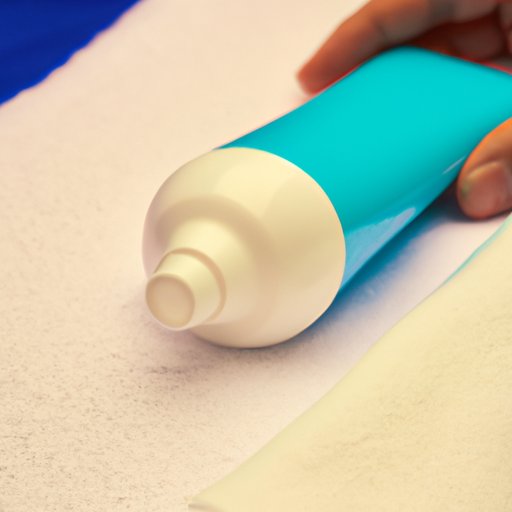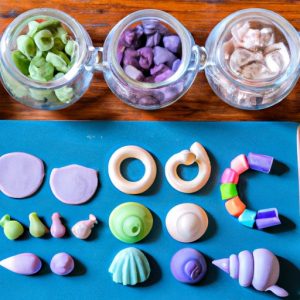
Introduction
Sun spots are a common skin issue that occurs due to prolonged exposure to the sun’s harmful UV rays. Also called age spots or liver spots, they usually appear on the face, hands, and other areas frequently exposed to sunlight. While sun spots are not harmful, they can be unsightly and affect a person’s appearance, leading to a lack of self-confidence. This article will explore the science behind sunspots, different natural remedies, topical treatments, and professional treatments to prevent and get rid of sun spots.
The Science Behind Sun Spots and Its Causes
Sunspots are darkened, flat patches of skin that occur due to excess melanin production. Melanin is the pigment responsible for giving color to your skin. The sun’s UV rays can damage the skin and result in the production of excess melanin in one area, causing sunspots. Age also plays a role in the development of sunspots because as we get older, the skin’s ability to regenerate rapidly slows down.
Natural Remedies to Prevent and Diminish Sun Spots
Several natural remedies can help prevent and diminish sun spots:
Lemon juice
The citric acid in lemon juice acts as a natural skin lightener, making it a popular remedy for sunspots. Apply freshly squeezed lemon juice to the affected area and leave it on for 15 to 20 minutes before rinsing it off with water to lessen the appearance of sunspots.
Aloe vera
Aloe vera soothes the skin and promotes healing, making it an effective remedy for sunspots. Apply fresh aloe vera gel to the affected area and leave it on for 30 minutes before rinsing it off with water.
Green tea
Green tea contains antioxidants that help reduce sunspots by neutralizing free radicals that damage the skin. Brew green tea and let it cool. Use a cotton ball to apply the tea to the affected areas, leave it on for 10 to 15 minutes, and rinse it off with cool water.
Vitamin C
Vitamin C is known for its skin-brightening properties and can help reduce the appearance of sunspots. Use a Vitamin C serum to apply to the affected areas before moisturizing, or consume more Vitamin C-rich foods like oranges and strawberries to brighten your overall skin tone.
Turmeric
Turmeric has an active ingredient called curcumin that helps lighten the skin and reduce the appearance of sunspots. Mix turmeric powder, honey, and milk into a paste and apply it to the affected areas. Leave it on for 15 to 20 minutes before rinsing it off with water.
Apple cider vinegar
Apple cider vinegar is a natural astringent that helps reduce the appearance of sunspots by breaking down excess melanin in the skin. Mix equal parts water and apple cider vinegar, and apply it to the affected area with a cotton ball. Leave it on for a few minutes before rinsing it off with cold water.
Topical Treatments That Work Best for Sun Spots
Several topical treatments are effective in treating sunspots:
Hydroquinone
Hydroquinone is an over-the-counter remedy that contains bleaching agents that help reduce the appearance of sunspots. It works by inhibiting the production of melanin. Apply to the affected areas as directed for the best results.
Retinoids
Retinoids are topical creams or gels that promote skin cell turnover, reducing the appearance of sunspots. They also help reduce fine lines and wrinkles. Apply to the affected areas as directed, and avoid sun exposure as much as possible when using Retinoids as they can leave your skin more sensitive to the sun’s rays.
Azelaic acid
Azelaic acid is a topical cream that helps reduce the appearance of sunspots by inhibiting the production of melanin. It also has anti-inflammatory properties that can help treat acne and rosacea. Apply to the affected areas as directed.
Kojic acid
Kojic acid is derived from mushrooms and rice and is used in topical treatments to reduce the appearance of sunspots. It inhibits melanin production, making it an effective ingredient for skin brightening. Apply to the affected areas as directed for maximum effect.
Glycolic acid
Glycolic acid is an alpha-hydroxy acid (AHA) that exfoliates the skin, revealing a brighter and clearer complexion. It also helps reduce hyperpigmentation caused by sunspots.
Vitamin E
Vitamin E is an antioxidant that helps protect the skin from environmental stressors that cause sunspots and helps reduce inflammation. Apply to the affected areas as directed or consume more Vitamin E rich foods like nuts, and kale.
Professional Treatments to Remove Sun Spots
If natural remedies and topical treatments don’t work, several professional treatments can remove sunspots.
Laser therapy
Laser therapy uses intense pulsed light to target the pigmented cells responsible for sunspots, breaking them down and allowing your body to naturally exfoliate them away. The process generally takes several sessions to see results.
Chemical peels
A chemical peel is a treatment in which a chemical solution is applied to the skin, causing it to exfoliate and de-pigment to reduce the appearance of sunspots. This treatment can be painful and requires several days of downtime for the skin to heal.
Microdermabrasion
Microdermabrasion exfoliates the top layer of skin, removing excess pigment that has accumulated on the surface. It’s a non-invasive procedure that improves overall skin texture and tone. The treatment typically takes 30 minutes, and results are seen in a few weeks.
Cryotherapy
Cryotherapy uses liquid nitrogen to freeze sunspots, causing them to scab and fall off. The process is quick and usually takes less than a minute to complete. Sunspots will darken and fall off within a few days of the treatment.
Phototherapy
Phototherapy uses intense pulsed light to treat sunspots by breaking down excess melanin in the skin. The treatment helps to even out skin tone and reduce the appearance of sunspots.
Lifestyle Changes to Avoid Sun Spots
Avoiding sunspots can be as simple as making a few lifestyle changes:
Wearing protective clothing
Wearing protective clothing, such as hats, long sleeves, and sunglasses, can help protect your skin from the sun’s harmful UV rays.
Staying in the shade
Staying in the shade can help reduce your exposure to the sun and lower your chances of developing sunspots.
Avoiding the sun during peak hours
The sun’s UV rays are strongest between 10 am and 2 pm, so it’s best to avoid direct sunlight during this time.
Staying hydrated
Staying hydrated helps keep your skin healthy and may reduce the risk of sunspots by ensuring your skin stays in good condition.
Eating a healthy diet
Eating a healthy diet rich in fruits and vegetables provides your skin with essential vitamins and minerals that keep it healthy and may reduce the risk of sunspots.

Sunscreen Use and Its Importance in Preventing Sun Spots
Using sunscreen is the most effective way to prevent sunspots. When selecting a sunscreen, choose one that has an SPF of 30 or higher and provides broad-spectrum protection against UVA and UVB rays. Apply sunscreen to all exposed areas of skin and reapply regularly throughout the day, especially if you’re swimming or sweating.
Conclusion
Sun spots can affect your appearance and lead to a lack of self-confidence. However, there are many natural remedies and treatments available to prevent and remove sunspots. By making lifestyle changes and using sunscreen, you can avoid the development of sunspots altogether. If you have persistent sunspots, consider seeking professional treatments to remove them and restore your skin’s natural radiance.





